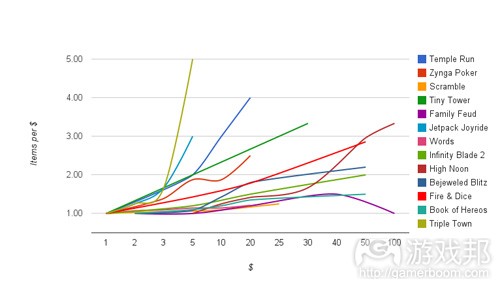分析iOS游戏货币售价的批量购买优惠设计
作者:Zack Hiwiller
我刚刚完成了每周一晚的数据分析,于是我开始考虑手机游戏中的微交易模型。在决定《火与骰子》中城市钥匙的价格时,我用数学计算来做指导。最终得到的结果是:
7把钥匙,1美元,14.3美分/把;
50把钥匙,5美元,10美分/把;
250把钥匙,20美元,8美分/把;
1000把钥匙,50美元,5美分/把。
这种设置符合广义的“麦乐鸡经济学法则”,该法则与逐渐减少的边际效用有关。根据该法则所述,20块麦乐鸡的售价应当低于4倍的5块麦乐鸡售价。否则,麦乐鸡套购会让商品的未来发展变得混乱。
因此,我们知道每MTX货币单位的售价应当随出售量的增加而减少(游戏邦注:或保持不变)。如果我一次性购买1000个Farmville Bux,所耗费的金钱数应当少于我购买10次100个Farmville Bux。但是,每美元单位应当降价多少呢?换句话说,大批量购买应当比多次小批量购买便宜多少呢?
我进行了一项非科学化研究,查看手机上13款游戏可除尽货币的价格点。我打开电子数据表,制定标准单位,随后我用标注单位除于价格点。我期望通过这种方法能够获得Zynga等各大公司运算法则的启示性曲线。我得到的结果如下图所示:
没有提供“批量购买优惠”的货币走势将会与“1”重合,因为在任何价格点,你购买单位的成本都是相同的。曲线上扬越高,就意味着用户获得的“批量购买折扣”越大。如果存在次级MTX货币市场,你会发现所有这些曲线将越来越向“1”靠近,因为套利者会购买大量MTX货币,然后以比供应商的1美元水平更低的价格出售。
以下是“1”到“2”范围内的走势放大图:
我调查的这13款价格容易除尽的游戏为我的设计提供了许多建议。
1、首先,《Triple Town》的5美元货币包是目前最棒且廉价的货币包,它显得1美元、2美元和3美元包的定价都过高。《Triple Town》中5美元包提供的货币数量是5个1美元货币包数量的25倍。其他游戏都没有这么做。为什么不呢?是否因为我们担心将鲸鱼用户喂得太饱?游戏通过这种设计促进用户购买最大的货币包。
2、在本次调查的游戏中,每款游戏都有5美元包,但是并非每款游戏都有1美元包。
3、Ludia负责设计的人在基础数学方面有欠缺,因为他们的旗下游戏《Family Feud & Friends》中40美元包提供的货币数量要多于100美元货币包。
4、这样谁还会购买100美元包呢?开发者设计这个选项,难道只是寄希望于玩家意外点到按键而购买?
5、Newtoy(游戏邦注:现为Zynga with Friends团队)的游戏曲线最为平滑。他们并没有提供过多的批量购买优惠。
6、忽视《Zynga Poker》3到5美元和《Triple Town》2到3美元这两段怪异的曲线。因为Google Doc的曲线呈现有一定偏差。
7、尽管我们的游戏《火与骰子》在小于5美元范围内的走势与其他游戏相近,但是20美元之后我们的优惠比例就呈现出了差异。我觉得,每个人都同意在1到5美元的范围内优惠10%到50%,但是将这个比例用在100美元优惠包上并非高明的做法,我认为需要给用户提供更大的优惠。
以上数据分析只能作为一种参考,你要设定适合自己游戏的优惠比例。
游戏邦注:本文发稿于2012年1月30日,所涉时间、事件和数据均以此为准。(本文为游戏邦/gamerboom.com编译,拒绝任何不保留版权的转载,如需转载请联系:游戏邦)
Bulk Savings on iOS Game Currencies
Zack Hiwiller
I was doing some Monday Night Data Analysis (you know how it is) and I got to thinking about the microtransaction models in mobile games. When deciding on the values of Keys To The City in Fire & Dice, I just kind of stuck my finger in the air and let some math cushion my fall. Here’s what we ended up with: 7 Keys, $1, 14.3c/key; 50 Keys, $5, 10c/key; 250 Keys, $20, 8c/key; 1,000 Keys, $50, 5c/key.
That makes sense according to the Greater McNugget Law of Economics which has something to do with decreasing marginal utility and states that a 20-piece Chicken McNuggets should cost less than buying 5 4-piece Chicken McNuggets separately. Otherwise, McNugget arbitrage would throw commodity futures into chaos. Or something.
So we know that the cost per unit of MTX currency should go down (or stay steady) as the amount spent goes up. If I buy 1,000 Farmville Bux at a clip, it should cost me less than buying 100 Farmville Bux ten times. But how much should it go down per dollar? How much cheaper should it be?
I did this incredibly unscientific study of looking at the price points of divisible currencies in 13 of the games on my phone. I fired up the spreadsheet machine and standardized the units, then I divided the standardized units by the price point. I expected to get some revelatory curve that would distill the hive brain of Zynga-Playfish-Playdom-EvilCo’s money extraction algorithms. Here’s what I got instead:
A currency that provides no “bulk savings” would be just a flat line across at 1 because at any price point you would always be getting the same unit cost. The higher the curve goes up, the greater the “bulk discount” is for users. If there was an easy secondary MTX currency market, you would see all of these pressed flatter and flatter because arbitrageurs could just buy huge bundles of MTX currency and dole it out at cheaper than the supplier’s $1 level.
Here’s a zoom-in of the 1 to 2 range:
The sample of thirteen games available to me at the time that had easily divisible amounts provided quite a variety of suggestions.
First, Danc is a saint because Triple Town’s $5 currency bundle is either the most wonderful affordable currency bundle out right now or the $1, $2 and $3 bundles are vastly overpriced. The $5 bundle in Triple Town gives 25x the number of coins of the $1 bundle for 5x the cost. No one else does that. Why not? Are we afraid of over-saturating our whales? Give the people that buy the biggest bundle as much as they could possibly ever use. user.giveTokens(MAXINT);
Every single game I looked at had a $5 bundle, but not every game had a $1 bundle.
Someone at Ludia can’t do basic math because their $40 bundle on Family Feud & Friends provides more bang for buck than their $100 bundle.
Who buys $100 bundles? Why aren’t they buying the $50 Fire & Dice bundle? Do we devs just put those out there to see if people will hit the button by accident like the I Am Rich app?
Newtoy’s (er, Zynga with Friends’) games have the flattest curves. They really don’t offer much in the way of bulk savings.
Ignore the weird curve thing going on with the Zynga Poker line from $3-$5 and the Triple Town line from $2 to $3. Google Doc’s curve smoothing wasn’t up to the task.
While there seems to be similarity in the <$5 range (if you average the curves, you get about what we did for Fire & Dice!), once we crack $20 we get into crazy bux funtown. The curves diverge quite a bit. I think everyone can agree on 10%-50% bumps in the $1-$5 range, but the parabola gets so stupid when you get into $100 games that I guess you just pick a large number and throw it at the user.
Make your own conclusions, though. It could all just be noise. (Source: zack hiwiller)









































 闽公网安备35020302001549号
闽公网安备35020302001549号